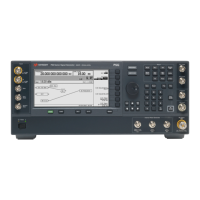Keysight Signal Generators Programming Guide 341
Creating and Downloading User–Data Files
User File Data (Bit/Binary) Downloads (E4438C and E8267D)
• <directory> is the signal generator’s BIT or BIN directory.
6. At the ftp prompt, type: bye
7. At the command prompt, type: exit
Understanding Framed Transmission For Real–Time TDMA
Specifying a user file as the data source for a framed transmission provides you with an easy method
to multiplex real data into internally generated TDMA framing. The user file fills the data fields of
the active timeslot in the first frame, and continue to fill the same timeslot of successive frames as
long as there is more data in the file with enough bits to fill the data field. This functionality enables
a communications system designer to download and modulate proprietary data sequences, specific PN
sequences, or simulate multiframe transmission such as those specified by some mobile
communications protocols. As the example in the following figure shows, a GSM multiframe
transmission requires 26 frames for speech.
Figure 6-1 GSM Multiframe Transmission
When you select a user file as the data source for a framed transmission, the signal generator’s
firmware loads PRAM with the framing protocol of the active TDMA format. This creates a file named
AUTOGEN_PRAM_1 in addition to a copy of the user file. For all addresses corresponding to active
(on) timeslots, the signal generator sets the burst bit to 1 and fills the data fields with the user file
data. Other bits are set according to the configuration selected. For inactive (off) timeslots, the signal
generator sets the burst control bit to 0, with the data being unspecified.
In the last byte that contains the last user file data bit, the signal generator sets the Pattern Reset bit
to 1. This causes the user file data pattern to repeat in the next frame.
NOTE The data in PRAM is static. Firmware writes to PRAM once for the configuration selected

